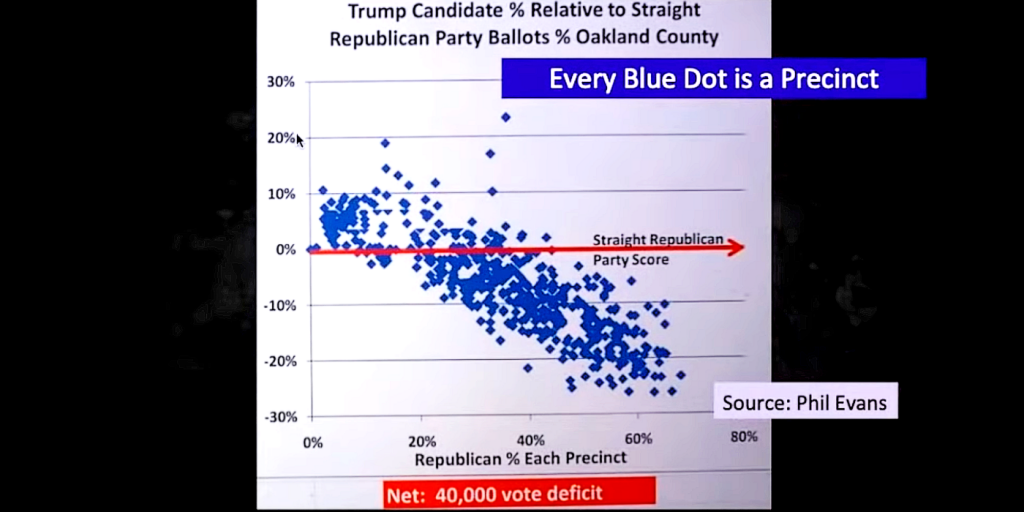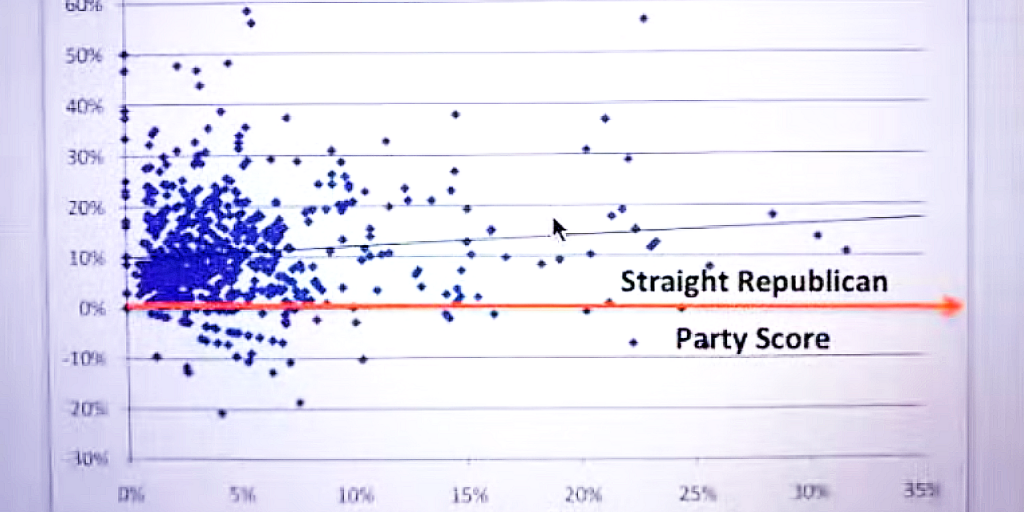A group of computer scientists led by Dr. Shiva Ayyadurai, an MIT-educated Fulbright Scholar, presented what appeared to be a cut-and-dry case of systemic fraud that stemmed from the voting software used in several Michigan counties.
The discrepancies in three counties alone may have been more than enough to explain a suspicious jump of nearly 130,000 votes in the wee hours of the morning after the Nov. 3 election.
According to the scientists, 69,000 votes in the counties appeared to have been taken from President Donald Trump and given to Democrat candidate Joe Biden—a net gain of 138,000 votes for Biden, whose current projected lead in the state is just over 146,000.
Mr. President @realDonaldTrump
& Mr. Biden @JoeBidenOur analysis in Michigan indicates a computer algorithm was likely used to transfer 69,000 votes. We are willing to subject our results to a critical & transparent review with your representatives. Are you open?
-Dr. Shiva
— Dr.SHIVA Ayyadurai, MIT PhD. Inventor of Email (@va_shiva) November 11, 2020
However, it is likely that further analysis may reveal the same trend occurring in other counties in Michigan—and also in other states.
“What we see is a beautiful line, which you could go back to your algebra class and write an equation for,” Ayyadurai said in a livestream video posted to his website.
Ayyadurai—who ran as an independent in the 2020 race to unseat Sen. Ed Markey, D-Mass.—said he had observed similar patterns in the data from his own home state.
Meanwhile, Trump tweeted on Thursday that 2.7 million votes may have been deleted, including hundreds of thousands in Pennsylvania, another crucial battleground state where Biden holds a projected lead of around 54,000 votes.
“REPORT: DOMINION DELETED 2.7 MILLION TRUMP VOTES NATIONWIDE. DATA ANALYSIS FINDS 221,000 PENNSYLVANIA VOTES SWITCHED FROM PRESIDENT TRUMP TO BIDEN. 941,000 TRUMP VOTES DELETED. STATES USING DOMINION VOTING SYSTEMS SWITCHED 435,000 VOTES FROM TRUMP TO BIDEN.” @ChanelRion @OANN
— Donald J. Trump (@realDonaldTrump) November 12, 2020
Much of the focus in the lead-up to the election was on the potential for fraud based on early mail-in voting.
But, in fact, large numbers of hand-counted paper ballots may actually have prevented the fraud in some areas, said the scientists.
Rather, the data analyzing election results in four of Michigan’s largest counties—if accurately presented—showed a stunning algorithmic effort to increase the suppression of votes based on the probability that a precinct tended to vote Republican.
The pattern “makes no sense unless a computer algorithm was in place to lower Trump’s votes as a function of Republicanism in a precinct,” Ayyadurai said.
“Our position is that it could only be done by a computer algorithm in such a precise way over so many precincts,” he added.
In Oakland, Macomb and Kent counties, the pattern of support for Trump showed a downward regression line as county precincts grew more Republican.

But in Wayne County, which contains much of the Detroit metropolitan region, no such pattern existed—signaling that, for whatever reason, this alarming feature of the voting software was not toggled.
It may be because of the extra scrutiny placed on Detroit, with Trump calling on his supporters to watch the elections in blue-run cities very carefully; or it may be that Democrats wanted to avoid the risk of disenfranchising their own voters in the heavily minority area, which would have escalated the voting abuse into a civil-rights case.
Remarkably, without the algorithm in place, the diagram showed that Trump garnered considerably more support in Detroit than the generic Republican might have.

‘Too Perfect’
An unusual aspect of Michigan’s voting allowed the data experts to conduct the comparative analysis, which used a precinct’s tendency to vote Republican as its baseline (x-axis) variable.
The state records whether a voter selected candidates individually or chose candidates of a single ticket straight down the party line.
That let analysts use as their constant the degree to which residents tended to vote for the entire Republican ticket, and to compare that with those who broke rank to vote for or against Trump.
However, this data point gauging the precincts’ levels of ‘Republicanism’ also was likely what allowed the voting software’s algorithms to determine which regions to suppress and to what extent.
The algorithm often appeared to kick in when at least 20 percent of a precinct’s voters were party-line Republicans.
At that point, the variance between Trump’s support and that of a typical Republican went down proportionately based on how Republican the particular precincts were.
“It seems like going to Republican precincts was his worst nightmare,” Ayyadurai said. ” … The more the precinct was Republican, the more the percent of Trump votes are transferred to Biden.”
The noticeable pattern of the line made it immediately clear to the expert analysts that the trends were more than a random occurrence.
“If you look at this, you say something’s up,” Ayyadurai noted. “This is too structured, too perfect.”
Likewise, the scientists refuted claims that the data could be an accurate reflection of the fact that Trump had alienated traditional Republican voters.
If so, the line would not have a downward slope. Rather, it would have run parallel to the Republican constant but below the baseline.

“Even if you want to believe that Republicans hated Trump so much, the larger that the population sizes were, they still wouldn’t be able to hate him in such a perfect line,” said Bennie Smith, a data analyst and election commissioner who joined Ayyadurai for the livestream.
Clemson University data analyst Phil Evans, who compiled the Michigan data, also called in for the stream via telephone.
A Statistical ‘Gift’
With 99 percent certainty, Smith estimated it was virtually impossible that the downward regression line in the three counties could have been a random fluke.
It was, in fact, the acknowledgement of problems in another Michigan district, Antrim County, that first called attention to the possibility that the voting machines were up to something nefarious.
The county, characterized in the Detroit Free Press as a “Republican stronghold,” said that a so-called glitch in the software from Dominion Voting Systems had resulted in thousands of Trump votes being transferred to Biden.
“We already knew how to go and look,” Smith said, “but that was kind of a gift that somebody acknowledged that it was there.”
He said he’d been working on analyzing similar algorithms for about five years, and that such algorithms were known to be present in election software since at least 2001.
While Dominion—a company that is linked with powerful Democrat leaders including House Speaker Nancy Pelosi and the Clinton Foundation—has been the focus of scrutiny, Smith said that all computerized voting systems were likely to have derived from the same source code originated by the company Diebold Nixdorf.
The algorithm, known as the “Weighted Race Feature” was encoded into software, but it can be set to weight the races at varying levels—or not at all.
“For far too long, we’ve been looking at Venezuela or Afghanistan or other countries—‘Oh my God, those are banana republics!'” Ayyadurai said. “But the reality is that in the United States voting system, the inputs and the outputs to our voting systems are unverifiable.”
The scientist proposed several common-sense measures that would give voters and election-integrity watchdogs more control over the nebulous process.
That included:
- a national voter-registration card
- the use of more hand-marked paper ballots
- open-source software to provide more transparency
- legislative measures requiring that data be preserved and published
Science vs. Slander
The increasingly dictatorial Left has scrambled to discredit Ayyadurai as a conspiracy theorist, with his own Wikipedia page citing past claims about the internet (his Twitter account refers to him as the “inventor of email”) and more recently saying that the coronavirus was lab-engineered.
Others have sought to smear the Mumbai-born immigrant as a ‘white supremacist’ following his 2018 campaign against Sen. Elizabeth Warren, D-Mass., in which he ran on the slogan “Only a real Indian can defeat a fake Indian.”
But if his four degrees from the Massachusetts Institute of Technology are not proof enough of his credentials, the fact that Ayyadurai lays out the data in a way that is explainable and replicable for the common citizen should help to differentiate true science from left-wing-media gas-lighting.
“We live in a world right now of media companies who cherry-pick what they want, and they have an agenda,” said Ayyadurai, who previously received $750,000 as part of a high-profile libel lawsuit against the now-bankrupt gossip site Gawker.
Ayyadurai warned that the failures of the Fifth Estate to function as a check on Democratic corruption—and the media’s active efforts during the election to suppress valid facts while promoting disinformation—meant it is no longer enough to be passive consumers of information “if we want to truly be free citizens.”
He called on his audience to “get educated or be enslaved” and asked viewers to use the information he had presented to educate others.
“None of this is valuable if this kind of knowledge gets hidden away in some affidavit or some lawsuit or … it’s just in some YouTube channel that no one sees,” he said.
